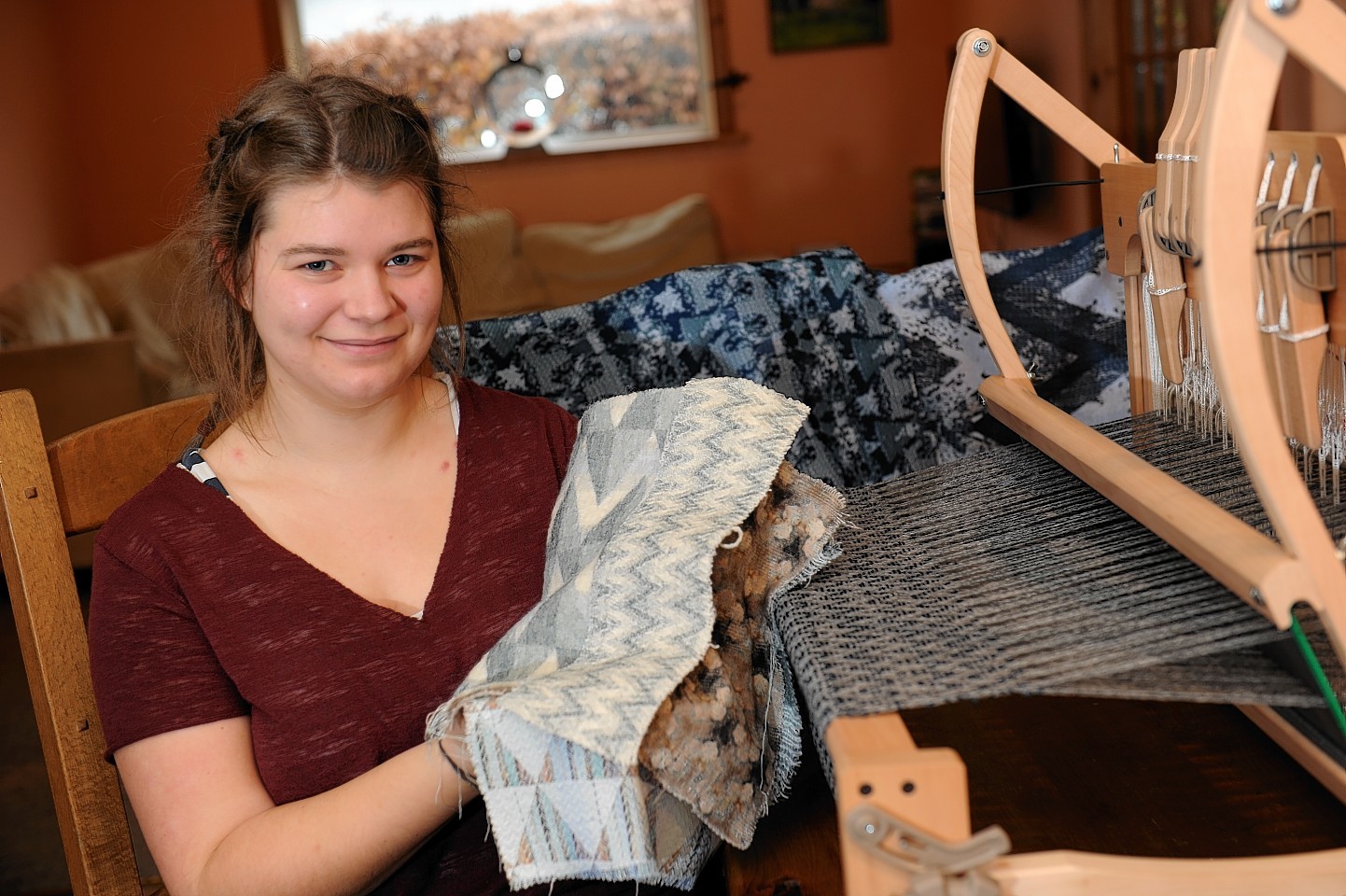A young Scottish weaver is pioneering the combination of traditional techniques with digital printing to produce a unique range of textiles.
Lucy MacDonald, 24, who is based in Banchory, is also collaborating with her uncle, one of Scotland’s best known wood carvers, to use their complementary skills to create furniture.
She had been accepted to study for a degree in television production but when she was offered work for a year in France, after backpacking around New Zealand, she postponed the start.
In the interim she decided to switch career paths and follow the advice her former art teacher had given her.
“I was always interested in art and after I made a costume for my art Higher the teacher suggested that I study textiles. At that point I didn’t even know there were such courses.”
She was accepted for a place at Heriot-Watt University, School of Textiles and Design in Galashiels and graduated with a BA (Hons) in Design for Textiles.
For her final year she took the bold step of attempting a previously untested technique of combining weaving and digital printing. Such was the success that it launched her business career.
“I was able to design a unique collection of contemporary interior textiles for the luxury market,” she said. “It is not something which has been done commercially because it cannot be produced on any great scale. I digitally printed warps (the lengthwise yarns) with repeat patterns before they were woven to create ikat-style fabric with a modern twist.
“It was exciting because there was very little I could find on this technique when researching it and it was fascinating to see the end results and discover which weave structures, yarns and printed patterns worked best compared to others.
“I also experimented with digitally printing my fabrics after they had been woven, using a variety of yarns including those such as polyester which resist the printing dye. I tried coloured yarns to produce interesting colour weave effects and textures.”
As part of the process she developed her own unique technique for stabilising warps to enable them to be digitally printed.
“By using a combination of weave structures I was able to experiment with how the weight of the fabric affected the digitally printed image and whether this in turn would have an effect on the finished textile.”
The success of the project prompted Ms MacDonald to launch her own company, Arra Textiles, which takes its name from her paternal great grandmother who lived on Orkney, the islands from which the patterns she produces derive.
“I have a passion for colour and geometric shapes and this is reflected in my work. I enjoy photography and my patterns are all based on natural images of different colours and textures which I took on Orkney and made into repeat patterns.
“The photographs I am using at the moment are of typical autumnal and winter colours and I am planning to return to Orkney to take photographs during the spring in order to produce my spring/summer range.”
At the moment Ms MacDonald is working on a small table loom in a room in her parents’ house which means production is limited to scarves and small household items like cushions.
However, backed by her family, she has invested in a large floor loom which is being shipped from California in January and will eventually be housed in a studio in the garden of her parents’ home.
“I have a table top loom at home and that restricts me to a width of 23 inches but the new loom will allow me to produce textiles with a width of up to 60 inches. This will enable me to design and produce a wide range of bespoke interior textiles including blankets, cushion covers, rugs, curtains and upholstery fabric for larger pieces of furniture.
“I also work on a small loom at the Wee Boorachie at the Milton of Crathes where I produce a range of luxury scarves which are available on my website as well as in the shop.
“Some people have expressed an interest in the fabrics for clothing but at the moment, with the exception of scarves, I am going to stick to interior furnishings.
“The challenge is getting my work seen by people but I will be going to trade shows and craft shows and I have been invited to display at an exhibition of Scottish designers/makers next year.
“I have been taking advice from Business Gateway and I am hoping to work with an agent who will help me to find an outlet for my work in London.
“I am aiming at the high end of the luxury textiles market, due to the nature of the process and the time taken with the design and production.
“It is not a process which could be carried out on a major commercial scale because each piece has to be handmade with no two pieces of cloth being exactly the same.
“However I see that as one of the major advantages because each customer will receive a unique and original piece.
“I have a range of original photographic designs which I digitally print on to hand-woven fabric, made using various weave structures and a mix of mainly natural yarns, to create one off, bespoke pieces.
“I am also collaborating with my uncle who is making a number of small stools for me which I will upholster.”
Ms MacDonald’s uncle is woodcarver and sculptor, Stephen Hayward of Hilton, Easter Ross, whose best known works include the 1.5 tonne Lewis Chessmen for the community of Uig on Lewis and “The Mermaid of the North” at Balintore.
Mr Hayward’s career started when, as a merchant seamen, he found a piece of dark wood lying under his bunk.
“I just started carving it,” he said. “I had never done anything like that before and I carved a paper knife with chain links on the end of it.”
